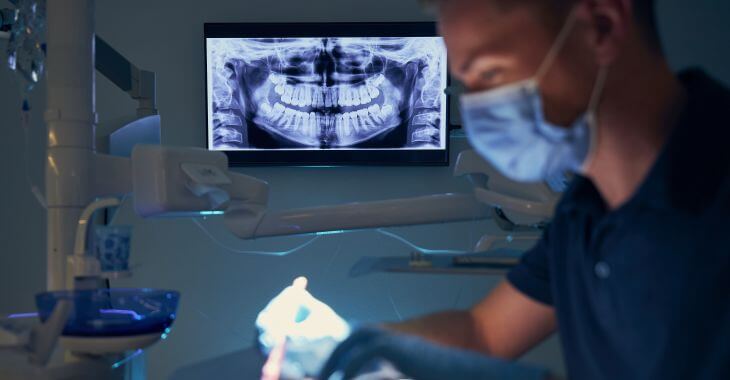What Are Signs of Dental Bone Graft Failure?

Lost teeth, nutrition, aging and periodontal disease can all impact the density of the bone in your jaw. To perform certain restorative procedures like dental implants, a dental bone graft may be needed to increase bone density in the jawbone. Bone grafts use bone tissue to stimulate bone growth, but there can be complications during this procedure. What can cause complications and what are the signs of dental bone graft failure? Here is what you need to know about dental bone graft surgery.
How Is Dental Bone Graft Surgery Performed?
Bone grafting is used to stimulate bone growth in weakened bones. One of the most common reasons bone grafting is needed for dental purposes is dental implants. Dental implants require enough bone to support the titanium posts and need to bond to the bone. To increase bone density, a dental bone graft may be performed before a dental implant procedure. Human bone tissue from a cadaver or the patient can be harvested, or there is synthetic or animal bone tissue that can be used.
To perform a bone graft, an incision is made in the gum tissue and a piece of bone tissue is inserted into the bone. This procedure is sometimes performed at the same time as a tooth extraction if there is evidence of bone loss. In some cases, the dentist may drill into the bone and insert the bone tissue into the hole. Screws or hardware may be used to hold the bone graft in place as it grows and becomes part of the jawbone. It can require a few months before the graft is strong enough to support a dental implant.
After oral surgery for a dental bone graft, it is normal to have some side effects while the surgery site heals. Swelling is common and there will be some pain for the first few days after surgery. Your dentist will likely prescribe antibiotics to prevent infection and you will be instructed to avoid certain foods, restrict activity and protect the surgery site during the first few days of recovery. Following post-surgery instructions is important to reduce risk of infection or other complications that can cause dental bone graft failure.
Causes and Signs of Dental Bone Graft Failure
Dental bone grafting is an effective procedure to increase bone in the jaw. Complications are not common – the most common concern is infection, which can occur with any surgery. Taking the required antibiotics and following the post-care instructions can greatly reduce any chance of infection. There are also risks of blood clots, nerve damage or problems caused by the anesthesia used during surgery, but these are rare. Last, bone graft failure can occur, which can be caused by infection or other factors.
Dental bone graft failure is uncommon, but it does occur. There are many different factors that can contribute to the bone graft not adhering to the jawbone. Medical conditions such as diabetes, autoimmune disorders and periodontal disease can impact the bone graft, especially conditions that cause poor blood supply that can affect healing. An allergic reaction to the bone graft (usually due to donor or synthetic bone tissue) can occur. Bone graft failure can also occur due to improper techniques used during the procedure.
When there are complications with a bone graft, there are symptoms to alert you to possible failure. This can happen any time after a bone graft is completed, even after a dental implant is put in place. Catching complications early may prevent complete bone graft failure. Signs of a dental bone graft failure or complications can include:
- Severe pain near the surgical site
- Fever accompanied by oral pain
- Swelling near surgical site after recovery period
- Teeth or implants feel loose near bone grafting site
- Gum receding around dental implant
- Problems biting or chewing

If you have any of these symptoms, especially within three months of a dental bone graft, you should contact your dentist or oral surgeon right away. These can be signs of dental bone graft failure. In some cases, the bone graft may be able to be saved with supportive therapy. If there is complete failure, the bone graft may need to be removed and the area debrided. Another bone graft can be attempted after the tissue heals for a few months.
In most cases, a dental bone graft is a safe and effective procedure that can stimulate bone growth in the jaw. Most procedures heal without any problems and improve oral health by strengthening the jawbone. If you undergo a bone graft procedure to support your teeth or a dental implant, follow your post-surgical care instructions carefully to avoid any preventable complications. If you notice any signs of dental bone graft failure, contact your dental team immediately for an appointment and urgent dental care.
The information provided on this website, including text, graphics, images, and other materials, is intended solely for informational purposes and should not be used as a substitute for professional medical advice, diagnosis, or treatment.



)